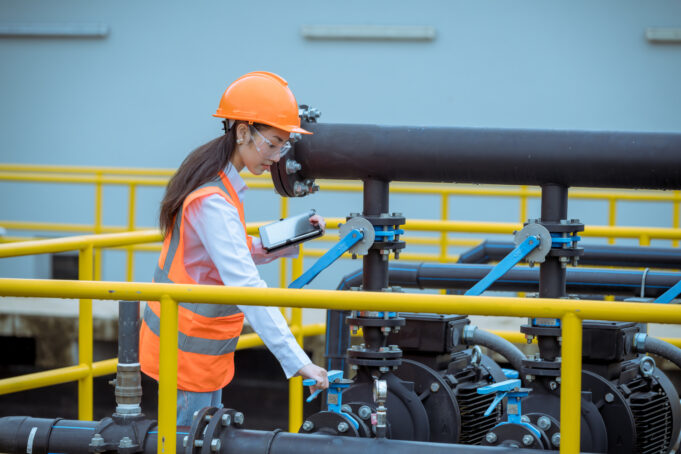Smart sensors, SCADA systems, digital twins, and AI-powered models are rapidly reshaping how treatment facilities operate today. But without skilled operators interpreting, adjusting, and collaborating with these tools, that data pipeline becomes little more than noise.
Smart systems alone won’t deliver better outcomes. People still matter. Water Treatment 411 dives into how collaboration between experienced operators, smart systems, and ongoing innovation is defining the next era of water treatment — and how to put it to work in your facility.
AI That Works With You (Not Instead of You)
From model predictive control to real-time anomaly detection, AI tools are equipping water professionals with faster insights and sharper foresight. Hybrid models that blend mechanistic process understanding with machine learning are now helping predict biological behaviors, stabilize effluent quality, and minimize energy use. But for AI to be useful, trust is essential. And trust hinges on explainability. Operators must know why the system recommends an action, not just what to do.
AI platforms that present decisions as black boxes, outputting setpoints without rationale, create a disconnect between system intelligence and operator expertise. Explainable AI bridges that gap. For example, instead of a system simply saying “reduce airflow,” it should add context like “because the oxygen uptake rate is falling and ammonia levels are climbing.” That level of clarity turns a passive command into an active decision supported by reasoning. The more clearly your systems communicate, the more effectively teams can respond.
Tools like DC Water’s RADS (Real-time AI-Driven Decision Support System) show what’s possible when AI is deployed with purpose. RADS interprets data to help operators manage treatment during extreme weather or potential cyber threats. It’s automated decision-making with smart, responsive support.
Field-Tested AI: Lessons from Desal and Wastewater
Desalination plants, notoriously energy-intensive and sensitive to pressure and fouling shifts, are seeing real gains through predictive AI. Tools like SUEZ’s MEMBoard can forecast failure points, empowering operators to act before the plant does.
In wastewater, the shift to hybrid AI models is gaining traction. These tools interpret plant data in real-time and feed insights back into control systems. For instance, France’s SIAAP is applying this tech to biofiltration, while Canada’s modelEAU group has proven its impact on nitrogen removal.
These are no longer pilot concepts. They are field-tested, operator-approved systems optimizing everything from chemical dosing to resilience planning.
Digital Twins: The New Training Gold Standard
Smart systems demand smart operators. But training on a live plant isn’t always feasible or safe. Enter digital twins. These are dynamic, virtual replicas of treatment systems that can simulate storm surges, equipment failures, or chemical imbalances in a no-risk environment. Real-world training applications featuring digital twin technology include:
- Simulating chemical overdoses or ammonia spikes for response training
- Practicing responses to equipment failures like blower trips
- Stress-testing facility resilience under cyberattack scenarios
- Forecasting compliance risks using real-time SCADA data
As we discussed in an earlier Water Treatment 411 piece, “A Blueprint for Cybersecurity Resilience in Water Operator Training”, digital upskilling must include preparation for cyber threats. Digital twins and AI platforms can support that mission by simulating attack scenarios alongside mechanical failures, giving teams a safe space to stress-test responses to threats across the board.
These theoretical tools are now standard in advanced training programs. Operators can rehearse responses to real-world crises with real-time SCADA data feeding virtual models. Combine that with simulator drills, dashboard refreshers, and monthly model check-ins, and you’ve got a workforce equipped for agile and accurate decision-making.
Closing the Gap Between Tech and the Treatment Room
If there’s one takeaway from the rise of AI in water treatment, it’s this: Continuous collaboration between operators, researchers, and developers is the real key to progress.
Field-tested tools built with frontline feedback are outperforming those created in silos. That’s why partnerships like the one between SUEZ and CNRS in France matter. They close the loop between lab innovation and plant operations.
When you let operators influence interface design, alert logic, and training formats, adoption is smoother and smarter. You build systems operators want to use, not ones they’re forced to tolerate.
Build People, Then Systems
Water professionals today don’t need to fear AI. They need to master it. The smartest systems will simply multiply a team’s expertise. But only if you’re in the loop. If you’re managing a facility, investing in your team’s training, interface literacy, and ability to critique and refine AI tools will pay off more than any one piece of software. Start now. Prioritize hands-on training with digital twins, push for explainable AI tools, and require vendor collaboration that includes your operations team. The ROI is in fewer compliance violations, quicker recovery from disruptions, and a team that’s ready for the next system update before it arrives.
The future of water treatment is digital. But it’s also still very human. Make sure you’re planning for both.
SOURCES: The Water Research Foundation, PNWS-AWWA, Water Science & Technology, Canada Research Chair on Water Quality Monitoring





